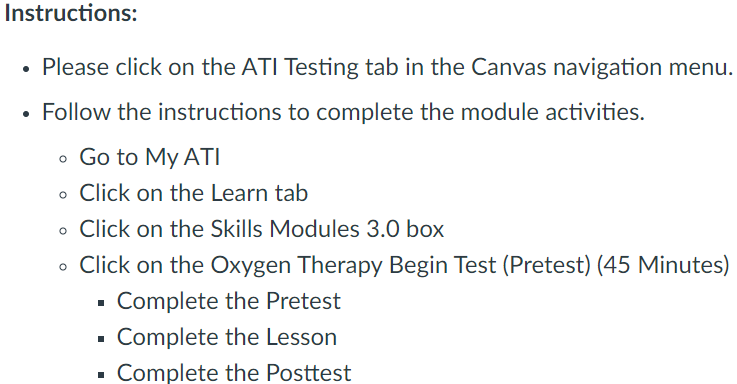NUR105 M3.5: ATI Skills Modules-Oxygen Therapy
Question: Administering oxygen therapy with a nonrebreather mask has which of the following advantages?NUR105 M3.5: ATI Skills Modules
Answer: A. offers the highest O2 concentration of the low-flow systems. NUR105 M3.5: ATI Skills Modules
Explanation: The nonrebreather mask offers the highest oxygen concentration among low-flow systems, delivering oxygen of 60% to 80%.NUR105 M3.5: ATI Skills Modules
Question: A nurse is caring for a client who has been receiving oxygen via nasal cannula for 4 hr. Which of the following assessment findings helps indicate that oxygen therapy has been effective?
Answer: A. respiratory rate 14/min
Explanation: An effective outcome of oxygen therapy is a respiratory rate within the normal range (12 – 20 breaths per minute).NUR105 M3.5: ATI Skills Modules
Question: A nurse is caring for a client who has dyspnea, slight cyanosis, and a respiratory rate of 28/min. During which of the following phases of the nursing process will the nurse determine the client has impaired gas exchange?
Answer: B. diagnosis.NUR105 M3.5: ATI Skills Modules
Explanation: Impaired gas exchange is determined during the diagnosis phase when the nurse analyses and interprets data gathered from the assessment.NUR105 M3.5: ATI Skills Modules
Question: A nurse should recognize that which of the following findings is an indication for oxygen therapy?
Answer: D. oxygen saturation (SaO2) 90% NUR105 M3.5: ATI Skills Modules
Explanation: Oxygen therapy is indicated when oxygen saturation levels fall below the desired range (95% – 100%).
Question: A nurse is caring for a client who was admitted with community-acquired pneumonia and has been receiving oxygen therapy for several days. Which of the following findings indicate an adverse effect of oxygen therapy?
Answer: C. cracks in the oral mucosa. NUR105 M3.5: ATI Skills Modules
Explanation: Oxygen therapy, especially when delivered without sufficient humidification, can lead to drying effects, such as cracks in the oral mucosa.
Question: A nurse is caring for a critically ill client who has COPD and requires delivery of a precise concentration of oxygen. Which of the following types of oxygen-delivery devices is indicated for this client?
Answer: C. venturi mask
Explanation: A venturi mask is used for critically ill clients who need precise control over the concentration of oxygen delivered.
Question: Oxygen therapy is prescribed for a client who is brought to an emergency department in the early stages of hypoxia. When assessing this client, a nurse should expect which of the following findings?
Answer: A. elevated blood pressure
Explanation: In the early stages of hypoxia, blood pressure is typically elevated.
Question: A nurse is caring for a client who has a tracheostomy. Which of the following pieces of equipment should the nurse use when administering oxygen to this client?
Answer: B. a tracheostomy collar
Explanation: A tracheostomy collar provides the client with the prescribed oxygen concentration and high humidity when administering oxygen to a client with a tracheostomy.
Question: A nurse is providing discharge teaching to a client who will continue oxygen therapy at home. The nurse should instruct the client that turning the knob on the oxygen flow meter all the way to the right…
Answer: D. stops the flow of oxygen
Explanation: Turning the knob all the way to the right stops the flow of oxygen from the cylinder to the client.
Question: A nurse is providing discharge teaching with a client who is going home on continuous liquid oxygen therapy. Which of the following instructions should the nurse include?
Answer: A. “place the oxygen tank in a clutter-free environment”
Explanation: Placing the oxygen tank in a clutter-free environment is essential for safety and efficient use.
Question: A home health nurse is teaching a client who has just started receiving oxygen therapy via mask. The nurse should emphasize that the client must…
Answer: B. reposition the elastic band frequently
Explanation: Repositioning the elastic band frequently helps prevent pressure on the skin, which can lead to skin breakdown.
For anyone seeking assistance with ATI testing, nursing education, or preparing for the NCLEX exam, I encourage you to consider our services at fixmygpa.com. We provide expert guidance and support to help you succeed in your nursing journey. Our team is dedicated to helping you achieve your goals and excel in your nursing career. Don’t hesitate to reach out for the support you need to thrive in your nursing education and exams!



